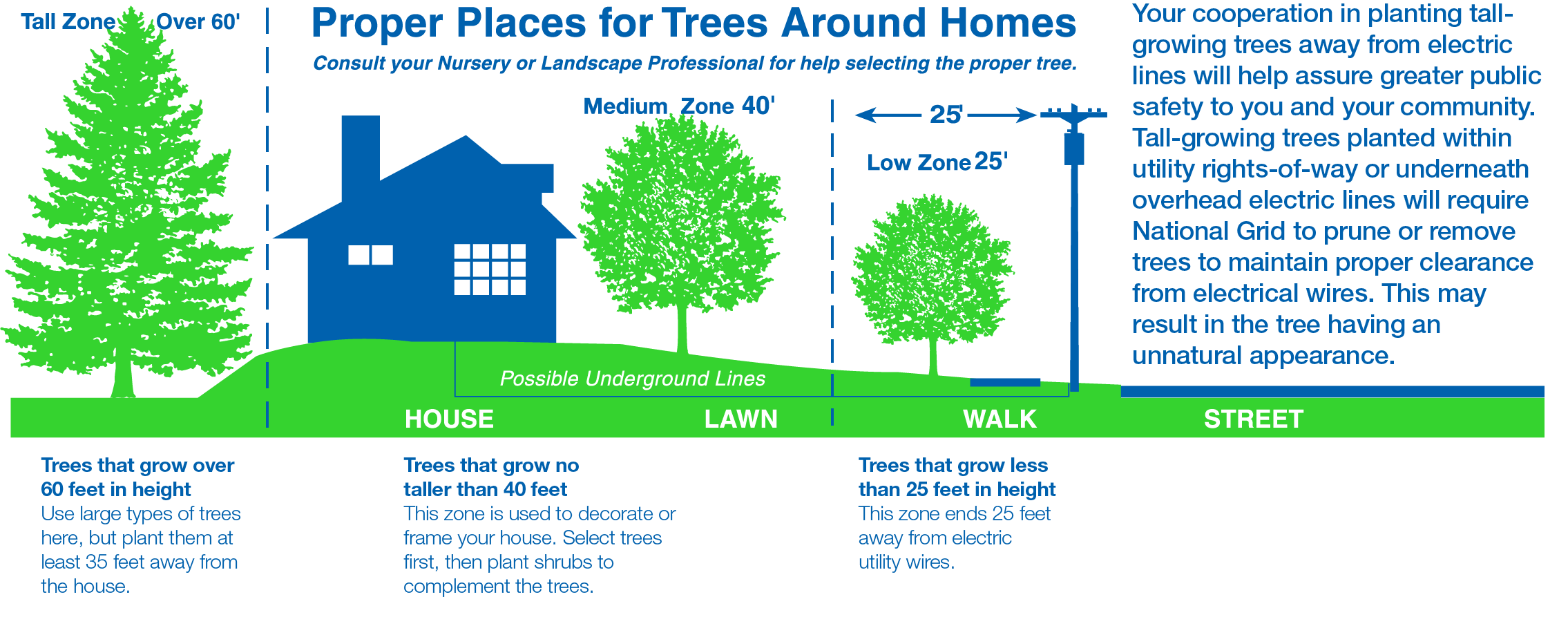Tree-trimming and power line safety
Our landscapes are starting to come alive with leaves and petals, and the weather is getting warmer. As many of us begin to clean-up our yards and find places for new plantings, springtime is a great reminder to follow these 4 steps for proper placement of trees around your house:
- Before planting, consider a tree’s full growth potential to see how the location of the tree will affect overhead or underground utilities.
- Within 25 feet of a utility pole, plant trees that grow less than 25 feet in height.
- Between your house and 25 feet from the utility pole, plant trees up to 40 feet in height.
- Make sure to plant a tree with a growth potential of more than 60 feet, at least 35 feet away from your house.

Learn more about our tree-trimming program to ensure that you’re able to safely enjoy the outdoors.
Trees enhance the quality of life in every community—converting carbon dioxide to oxygen—keeping the air clean. However, diseased and/or weakened trees, along with trees planted and growing near power lines, can contribute to power outages when they come in contact with overhead electric lines. National Grid’s goal is to ensure everyone’s safety and deliver reliable energy.
Since 2000, National Grid is proud to have repeatedly earned national recognition annually from the Arbor Day Foundation for its tree pruning programs as a “Tree Line USA” utility. We have demonstrated excellence in tree care practices, annual worker training, a commitment to customer and public education as well as supporting community tree planting through “right tree–right place” guidance. We are among a select few utilities to earn this prestigious honor.
Frequently-Asked questions
National Grid is responsible for routine pruning around our high voltage wires to maintain safe, reliable services to our customers.
Homeowners are responsible for pruning tree branches near the low voltage service drop to their individual home.
Many customers choose to remove these trees to reduce the risk that their tree may damage their home or electric service.
National Grid is available to work closely with your contractor to make the area safe for tree pruning or tree removal. In some cases, rubber sleeves can be placed over service wires. In other cases, it is necessary for us to temporarily disconnect your service lines from your home so that your contractor can safely prune or remove trees.
New York customers: By NYS law, there may be a charge to you or your contractor for such “make safe” procedures.
National Grid is responsible for only pruning around high voltage electric wires. Our forestry professionals assess each customer’s situation and will prune trees and branches that pose a risk to our high voltage electric distribution wires and overhead operations equipment. If a cycle prune for an area is scheduled, your pruning may occur at a later date. If the tree poses a risk to your individual service drop, your telephone or cable wires, please understand that National Grid is not responsible for pruning or removing those trees/branches.
National Grid uses directional pruning in accordance with accepted national tree pruning standards to prevent trees from coming into contact with high voltage wires. We apologize that while the tree’s appearance may be compromised, the procedure promotes proper wound closure and is only conducted to preserve public safety and prevent power outages.
Combat invasive tree-killing insects and help save the environment.
The introduction of invasive insects have destroyed hundreds of millions of trees in North America, costing millions and millions of dollars to remove dead or damaged trees from homes and communities, endangering our Northeast forests.
Trees that are damaged or killed by insects can also substantially contribute to power outages and increase costs as those dead or dying trees fall onto nearby overhead utility lines necessitating repairs. These insects are of particular interest in our Upstate New York and New England service territories. Look for and report these symptoms.
Emerald Ash Borer – small “D” shaped exit holes on ash trees, tree death from the top down and “S”–shaped larval galleries under the bark.
Asian Long-Horned Beetle – 3/8 inch round exit holes (the diameter of a pencil) on the trunk and branches, sawdust and sap on and around the trees, round pits in the bark (egg niches), often on maples, horse chestnut, birch and willow trees.
To protect your property, only purchase firewood that has been harvested locally or heat-treated to kill insect and disease pests. For more information and to report infestations:
- New York: Visit www.dec.ny.gov or call 866-640-0652 (email: firewood@gw.dec.state.ny.us).
- Massachusetts: If you think you have seen this beetle, we encourage you to submit a report and photos, or you can call Pest Hotline at 617-626-1779 or go to www.massnrc.org/pests/albreport.aspx— images may be sent directly to pestalert@massnrc.org
Learn more: Combat Tree-Killing Insects (pdf)
